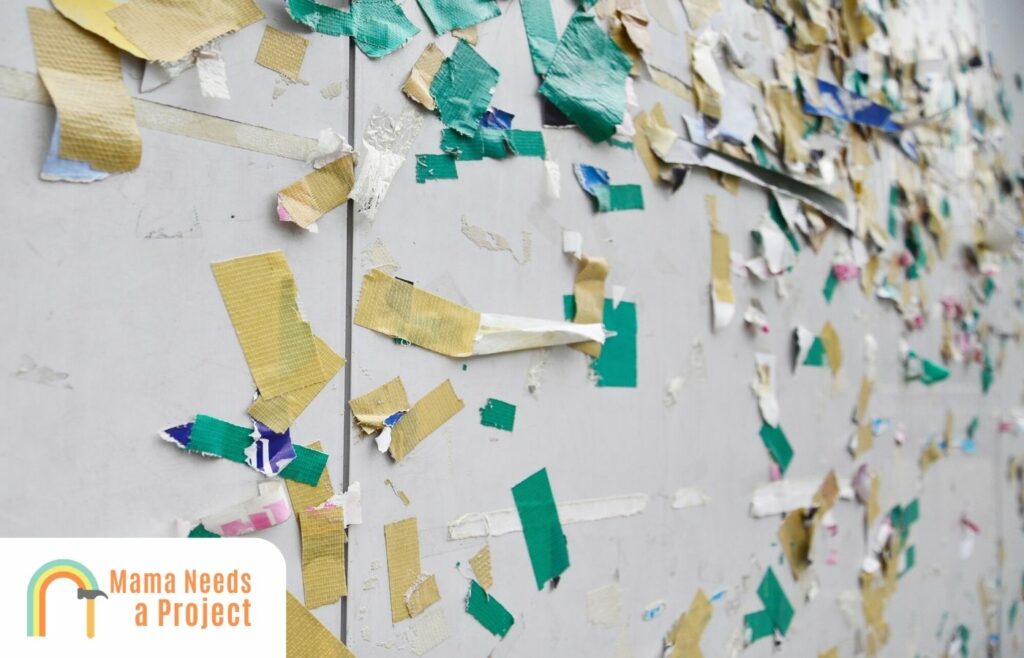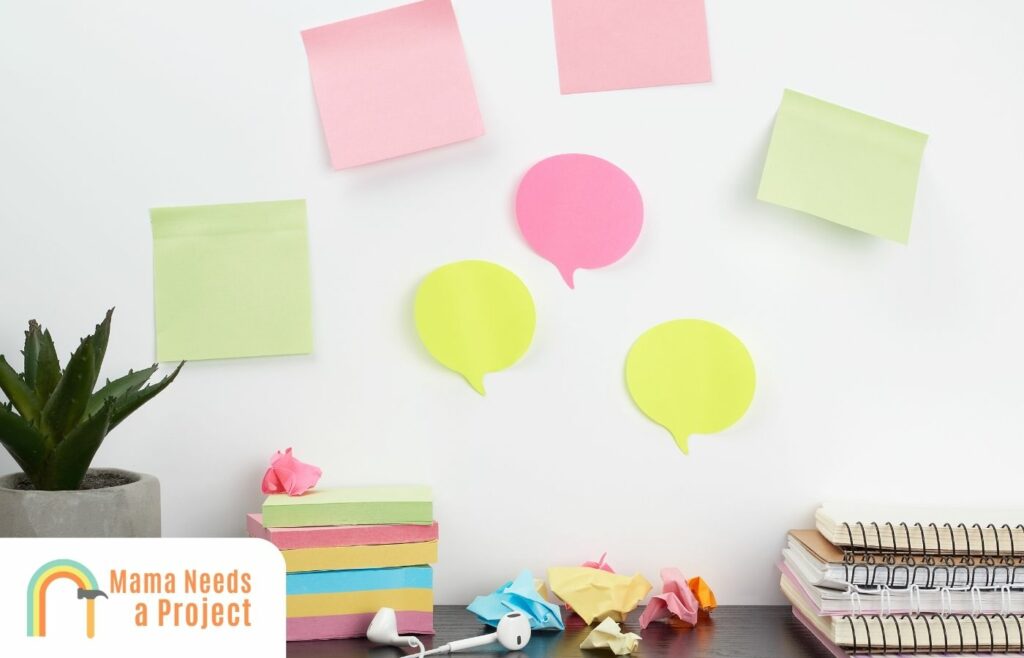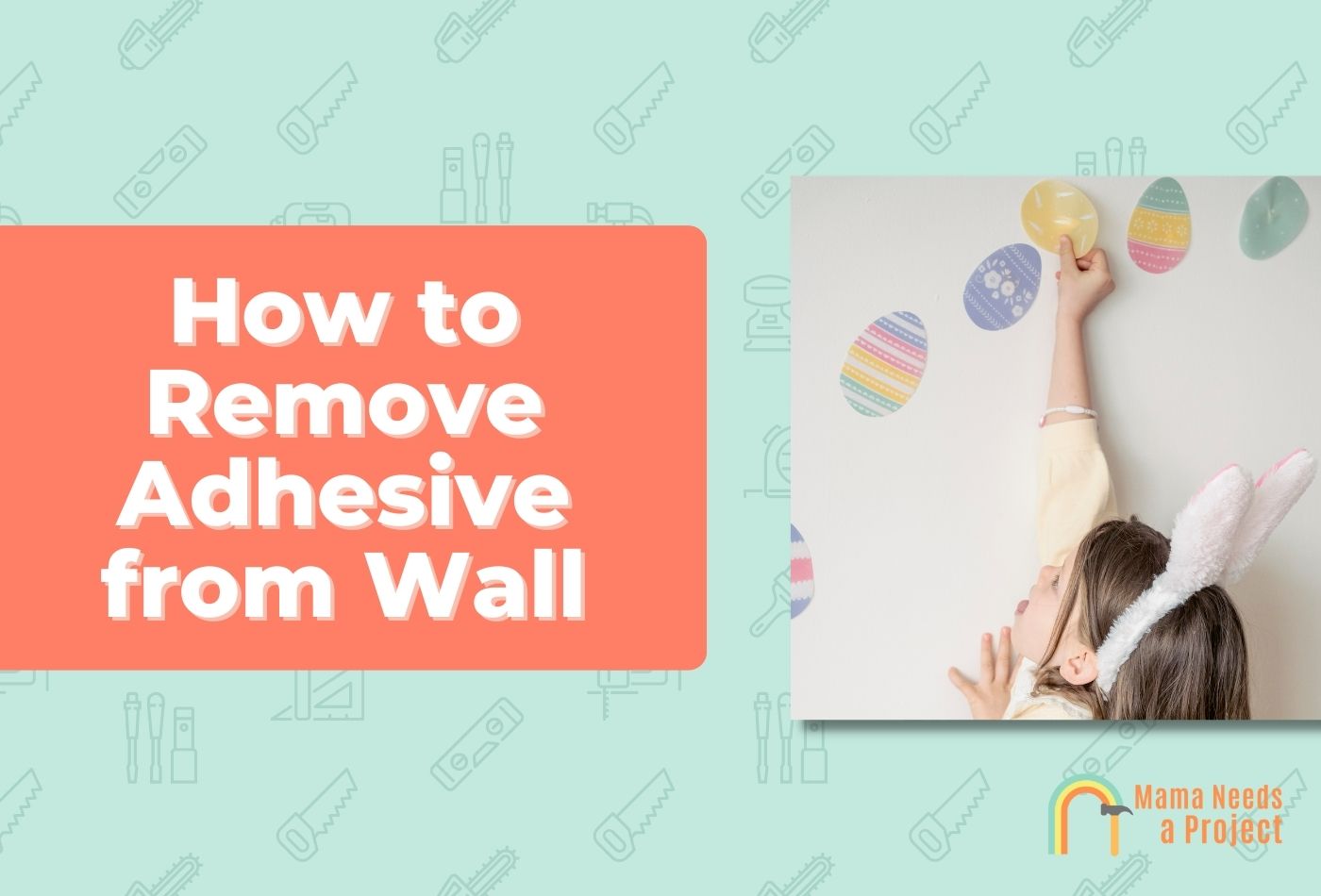How to Remove Adhesive from Walls (EASY Methods)
Thank goodness adhesives exist. They make attaching things to your wall so convenient, and we’re all grateful for that. But adhesives are definitely not easy to get unstuck. They almost do their job too well.
It’s common to face down with these stubborn adhesives during a home construction project, remodel, or a child with a sheet of stickers.
Wondering how to remove adhesive from wall surfaces? There’s pretty much nothing more annoying than sticker, glue, epoxy, or tape residue lingering.
You’ve tried desperately to pull it off, with little to no results. What now?
In this article, I’m going to share the simplest, most effective methods for how to remove adhesive from wall surfaces fast.
Ready to discover a surprisingly easy solution to this sticky adhesive problem? Let’s dig in!
- You can remove adhesive from wall surfaces by pulling off with fingers, washing with a hot water and dish soap solution, scraping with a razor blade, and heating with a heat gun or blow dryer.
- You can also use DIY ingredients from home to remove adhesive, like vinegar, dish soap, nail polish remover, Goo Gone, mayonnaise, and peanut butter.
- Common types of adhesive residue include tape, stickers, wood glue, sheetrock glue, Blu Tack, and epoxy. These can leave leftover residue that can be a pain to remove.
How to Remove Adhesive from Wall Surfaces
There are many reasons why you might find some adhesive stubbornly stuck to your wall. Adhesives are used for a wide variety of things, from sub-floorings and moldings, to tiling and wall-mounted mirrors.
You might also deal with troublesome adhesive when stickers get stuck to a wall, or something was taped or glued to the wall and removed.
To select the best method for cleaning off the adhesive in your home, you’ll need to know what type of wall adhesive you’re working with. Different materials yield different cleaning solutions.
Certain adhesives will react poorly to certain solvents and chemicals. That’s why it’s really important to have an understanding of what works best on the type of adhesive you’re trying to get rid of.
Prepping for Adhesive Removal
First, you’ll want to prep for the removal and cleaning process.
Any time you’re working with cleaners, especially chemical-based cleaners, you want to ensure you properly prepare. You don’t want any accidents or harmful health outcomes.
Take the following steps to thoroughly prepare your space for the adhesive removal:
- Put on safety gear. If you’re working with chemicals, especially commercial solutions like 3M or acetone, it’s recommended that you wear a respirator, gloves, and eye protection.
- Ventilate your space. Again, if you’re working with chemical cleaners, you don’t want to inhale these fumes. Some commercial-grade cleaners will cause mild respiratory symptoms. Make sure your room is ventilated as much as possible by opening doors, windows, or setting up fans to circulate fresh air in.
- Cover the floor with plastic or recycled paper. Protect your flooring below the wall. You’ll likely be working with liquid, which might drip down onto your floors.
- Make your cleaning solution. If you’re making one of the DIY cleaner options, you’ll want to prepare it ahead of time and set it up, along with any other supplies you need, at the adhesive site.
Great, now you’re ready to get rid of that nasty adhesive from your wall! Let’s get started.
Note: The following steps are designed to be safe for painted walls. We want to try everything we can to remove that adhesive before having to bring in heavier-duty commercial grade cleaning agents, some of which may strip or chip your wall paint.
1. Peel Off As Much as You Can

The first thing you should do is peel off as much of the sticker, tape, or glue as you can with your fingers.
Whether you’re trying to remove wall sticker residue or you’re trying to remove the leftover reside from adhesive hooks – try to scrape off as much as possible.
If there are any spare bits of one of these still left on the wall, you want to get off as much as you can manually before bringing in any tools.
To start, pinch one corner of the tape, glue, or sticker with your fingers. Then pull in one swift direction.
Once you get off as much of the leftover bits as possible, rub the adhesive itself in a circular motion with your fingers. This will create a beading effect, as the adhesive collects and comes off.
Still see more adhesive stuck to the wall? Proceed to Step 2.
2. Gently Scrape Off with a Razor Blade Scraper
The next step you should take if simply pulling all the adhesive item off didn’t fully work is taking a thin, sharp razor blade scraper to it.
A razor blade like this will work the best, but in a pinch you can use a thin, sturdy plastic item like an old credit card or putty knife.
Take your scraper, holding it nearly parallel to the wall, and drive it into the adhesive. It’s crucial to do this part gently and slowly, with minimal force.
Drive it into the adhesive too hard, and you could take out a chunk of sheetrock or paint.
This scraping step is usually very effective at getting most of the adhesive off. But if there’s still more to get off, try step 3.
3. Wash with Hot Water and Soap Cleaner

Step 3 could be done independently of all the other steps, because it can work for almost any type of adhesive without any bad reactions or paint damage.
In this step, you’ll be using trusty hot water and dish soap. This is the most paint-safe option, and is highly effective if you want to remove adhesive tape residue.
Mix a spray bottle or bowl of hot water with a couple tablespoons of mild dish or laundry soap. Then apply the mixture to a lint-free cloth.
Take the cloth to the wall, and hold it against the adhesive to get it wet. Make sure not to overly saturate your wall to prevent any sheetrock or paint damage.
Once the adhesive is moist with the soap and water, start rubbing it in circular motions with your fingers or the cloth. The adhesive should come off easily.
Want to use something other than soap for your DIY cleaner? Here are some alternative cleaners. Just double-check that the chemicals won’t react poorly with your specific type of adhesive.
Alternative cleaners:
- Warm water & vinegar
- Rubbing alcohol
- Mineral spirits
- Adhesive solvents
- Cleaning benzine
- Acetone / Nail polish remover (don’t use on painted walls)
- WD40
- 3M All Purpose Cleaner
- Goo Gone
- Peanut Butter or mayonnaise
4. Apply Heat to Remove the Adhesive

Okay: so you’ve tried everything. Soap and water, scraping, the works. And the adhesive is still there–ugh.
If you’re dealing with a really strong, heavy-duty adhesive, try removing it with heat.
This should remove any remaining residue from your walls without a problem.
Here’s how you do it: grab either a blow dryer, heat gun, or clothing steamer. Then begin applying heat directly over the adhesive.
If you’re using a blow dryer, put it on its high-heat setting. If you’re using a heat gun, put it on medium heat setting.
While applying heat, begin scraping off the adhesive using a thin razor blade or other thin, sturdy scraper. The heat will help separate the adhesive from the wall. Scrape gently so as not to take any paint off the wall.
Important note: make sure you’re scraping off the adhesive while applying heat. Don’t let the adhesive cool, as this will further set the adhesive.
Now that you’ve pulled, scraped, washed, and heated, your wall should be totally adhesive-free! Bravo.
Types of Adhesive to Remove from Wall
Read on to discover what types of adhesives you might find on a wall, and which cleaning agents work best for each type of adhesive.
Tape Adhesive or Sticker Residue
Wall tape residue or stickers are common adhesive offenders. These can leave annoying patchy spots, sticky material, and a gunky texture.
Remove these using:
- Rubbing alcohol
- Dish soap & hot water
- Hair dryer
- WD40
- Plastic scraper / putty knife
- Peanut butter / mayonnaise
Wallpaper Glue or Vinyl Residue
When you remove wallpaper or other fixtures from sheetrock, it’s common to find old glue or vinyl adhesive residue.
Luckily, these types of adhesive can be more brittle and easy to chip and pull off with your fingers than other types of residue. But if you need a little extra help, there are other options.
Remove wallpaper or vinyl glue using:
- Dish soap & hot water
- Vinegar
- Fabric softener
- Clothing steamer
Wood Glue Residue
Wood glue is commonly used in construction and furniture projects. Wood glue can be compared to epoxy in function and strength.
It’s possible that wood glue residue can end up on a wall or other wood piece.
Note that some of the wood glue can be pulled off with your fingers. But there are other ways to get rid of it if that fails.
Get wood glue residue off using:
- Acetone
- Nail polish remover
- Hair dryer / heat gun
Epoxy Residue
Epoxy resin can be very sticky, and if used for wall construction may leave behind heavy residue.
Remove epoxy adhesive using:
- Vinegar
- Acetone
- Dish soap & hot water
- Heat gun
- 3M all purpose cleaner
Did you accidentally get epoxy on your hands? Here’s how to remove resin from your skin safely.
Glue Stick Glue Residue
Did your kid’s school project go horribly wrong? Glue stick glue residue is fortunately quite easy to remove from a wall, no harsh chemicals necessary.
- Plastic scraper/putty knife
- Dish soap & hot water
- Rubbing alcohol & Q-tip
Sheetrock Glue Residue
Sheetrock glue adhesive is common on walls, but will take something a little stronger to remove.
Remove sheetrock glue adhesive using:
- Razor blade scraper
- Heat gun / blow dryer
- Mineral spirits
- Adhesive solvents
Blu Tack
Blu tack is commonly used to attach lighter-weight objects to walls. It can be removed from walls using:
- Blu tack
- Mineral turpentine
- Cleaning benzine
And yes, you read that right. Take some blu tack and rub it in circular motions over the stubborn blu tack residue. This should actually remove a lot of the residue, before you even have to turn to any chemical cleaners.
How to Avoid Damaging Paint When Removing Wall Adhesive
You might be feeling good about how to remove adhesive from wall surfaces by now. But what if your wall has paint, and you’re concerned about damaging it in the process?
That’s definitely a valid concern! Some harsher solvents can strip paint from a wall, like acetone.
Here are a few tips to avoid damaging paint on your wall:
- Only purchase a commercial adhesives cleaner specifically formulated to be paint-safe, like 3M or Goo Gone
- When using a razor blade scraper, don’t apply a lot of pressure. Hold the blade as flush to the wall as possible when scraping.
- Avoid overly saturating the wall surface with liquids or a clothing steamer.
- Avoid excessively heating the wall surface with a heat gun or blow dryer.
- Prep your wall with rubbing alcohol before you apply any adhesives in the first place, especially those meant to hang up mirrors, Command strips, or other decor items. This will prevent the adhesives from leaving behind residue in the future.
Additional Tips on Removing Adhesive from Walls
Need additional tips and tricks on all-things adhesive removal? I’ve got you covered!
- Always prep your space before working with any glue, chemical cleaners, and adhesive solvents.
- Only buy a commercial adhesive remover designed to be wall paint-safe. Goo Gone Original Liquid is a great example.
- Make or purchase a cleaner formulated specifically for the type of adhesive you’re trying to get rid of.
- Dealing with a really heavy-duty adhesive? 3M general purpose adhesive remover is really effective for extra-stubborn adhesive.
- If you’re working with commercial chemicals like 3M or WD40, it’s best to wear gloves and eye protection, and to clean in a well-ventilated space.
- WD40 can actually be used to remove heavy-duty adhesive.
- To use: spray it on the adhesive, leave for 30 seconds, scrape or wipe off with a towel. Then wash over the spot with soap and water to get rid of any greasy residue left behind by the WD40.
- Only use lint-free cloths, as other types of rags and towels can pill and leave little particles in the adhesive.
FAQs
Does vinegar remove sticky residue?
A solution of vinegar and warm water can remove sticky residue effectively and safely. Mix warm water and vinegar in a bowl or spray bottle, and apply to the adhesive spot. Let it sit for 30 seconds, and rub it down with a lint-free cloth until the residue is gone.
Can I use Goo Gone on painted walls?
Goo Gone is formulated to be safe for walls with paint. This commercial adhesive cleaner removes residue from walls without stripping or chipping any paint. That’s why it’s a useful product for anyone who doesn’t want to make their own DIY adhesive cleaner.
What is the easiest way to remove adhesive residue?
There are a dozen ways to easily remove adhesive residue. You can simply saturate the residue in warm water mixed with dish soap, and rub off with a lint-free cloth.
You can also apply mayonnaise or peanut butter to adhesive, let it sit for one hour, then wipe it off. Or apply a commercial cleaner like 3M or Goo Gone.
Final Thoughts
Bottom line: if you’re struggling to figure out how to remove adhesive from wall surfaces in your home, I have good news. Removing adhesive is quite simple!
Most of the time, all you’ll need is some hot water mixed with a little dish soap, a lint-free cloth, and a thin scraper.
Regular adhesives like tape, stickers, and wallpaper glue can easily be removed by wetting and rubbing off with a cloth. When you need a little extra help, apply heat, as heat helps break down the bonds in the adhesive.
Finally, if you’re simply not seeing results with your DIY cleaning methods, you can always purchase a commercial product designed to remove adhesive from walls.

Jessica Vaillancourt is a freelance writer and blogger obsessed with the Travel, Wellness, and Personal Development industries.
She has 5+ years of experience helping human-first agencies, global companies, and entrepreneurs crush their content marketing goals, and serve more people. Jessica’s work has appeared on leading websites like UpgradedHome.com, BetterHelp.com, and TheDiaryofaNomad.com.
Today, her sole focus (besides finding the world’s best coffee shop) is writing to serve humans, and slow traveling abroad to expand her mind. You can get to know her work at JessAnneWriting.com.

